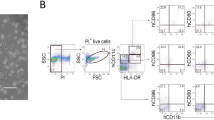Abstract
Although it is generally agreed that stromal cells are important in the regulation of haematopoietic cell development1–3, the origin of these phenotypically diverse cells has been a subject for debate for more than 50 years4. Data which support the concept of a separate origin for the haematopoietic stem cell and the marrow stroma are derived from cytogenetic or enzyme marker studies of explanted and expanded stromal cells grown under conditions that do not allow haematopoiesis in vitro5–7. Recent evidence in man8 and in mouse9 suggesting that the stromal cells capable of transferring the haematopoietic microenvironment in vitro are trans-plantable seemingly questions this dichotomy, one interpretation being the existence of a common haematopoietic/stromal 'stem cell'. We used in situ hybridization to discriminate donor cells from host in blood and bone marrow samples obtained from patients with functioning sex-mismatched but HLA-identical allografts. Without exception, marrow-derived stromal cells that proliferate in long-term cultures were found to be of host genotype, whereas the macrophage component of the adherent layer in these cultures originated from the donor.
Similar content being viewed by others
Author information
Authors and Affiliations
Rights and permissions
About this article
Cite this article
Simmons, P., Przepiorka, D., Thomas, E. et al. Host origin of marrow stromal cells following allogeneic bone marrow transplantation. Nature 328, 429–432 (1987). https://doi.org/10.1038/328429a0
Received:
Accepted:
Issue Date:
DOI: https://doi.org/10.1038/328429a0
- Springer Nature Limited
This article is cited by
-
Molecular and cellular mechanisms of liver fibrosis and its regression
Nature Reviews Gastroenterology & Hepatology (2021)
-
Use of MSCs and MSC-Educated Macrophages to Mitigate Hematopoietic Acute Radiation Syndrome
Current Stem Cell Reports (2020)
-
Parenchymal and stromal tissue regeneration of tooth organ by pivotal signals reinstated in decellularized matrix
Nature Materials (2019)
-
Biodistribution, migration and homing of systemically applied mesenchymal stem/stromal cells
Stem Cell Research & Therapy (2016)
-
Enhanced osteogenic potential of mesenchymal stem cells from cortical bone: a comparative analysis
Stem Cell Research & Therapy (2015)





